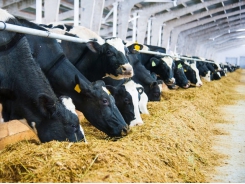Fishing by-product boosts cattle intake when added to forage diet

Supplementing cattle diets with chitosan boosts dry matter intake, digestion and ruminal behavior, say researchers.
A team of Brazilian researchers from several universities examined the use of multiple levels of chitosan (CHI) in beef cattle diets. The team published their results in the journal of Animal Feed Science and Technology.
“This study was carried out to determine the influence of increasing doses of CHI on nutrient intake and total apparent digestibility, ruminal fermentation, microbial protein synthesis, nitrogen utilization, and urea and creatinine metabolism of grazing beef steers,” said the researchers. They expected to find that it would improve fiber digestion, intake and fermentation, they added.
The group found that adding the feed ingredient to cattle diets could improve dry matter (DM) intake and digestibility and support microbial crude protein (CP) production.
“Chitosan supplementation to grazing steers positively affected DM intake and digestibility, increased ruminal propionate concentration and calculated microbial CP production,” said the researchers. “Based on regression equations of nutrient digestibility, ruminal propionate and microbial protein synthesis we recommend 900 mg CHI/kg of concentrate for grazing steers in tropical pastures receiving concentrate at 150 g/100 kg of LW [live weight].”
Why chitosan?
Chitosan is derived from a by-product of the fishing industry, chitin, said the researchers. And it is a readily available biopolymer.
It has been labeled as safe for use in food by the US Food and Drug Administration (FDA) and is considered non-toxic and biodegradable, they said. Previously, it has been examined for several applications including having antimicrobial activity and for use as a silage inoculant or as a rumen modulator.
The feed ingredient’s antimicrobial mechanism is not completely understood, said the authors. However, it is considered be involved in the intracellular leakage mechanism.
“In this theory, positively charged CHI binds to bacterial negatively charged surface, altering membrane permeability (hydrolysis of peptidoglycans), resulting in leakage of intracellular components and consequently cell death,” said the researchers.
When added to a predominately forage diet, it was reported to improve neutral detergent fiber (NDF), acid detergent fiber (ADF) and dry matter digestibility, they said. Research looking at its use in vitro found that it produced more volatile fatty acids than monensin, and that it could shift fermentation from acetate to propionate.
“It is expected that CHI supplementation should benefit fiber digestibility, pasture intake, and ruminal fermentation in grazing cattle,” they said.
Methods and materials
In the feeding trial, five steer were cannulated and fed one of five diets for a period of 21 days, said the researchers. Data were collected during the last seven days of each feeding period.
The diets used included chitosan at 0, 400, 800, 1,200 or 1,600 mg/kg dry matter of concentrate, they said. Concentrate was fed a 150 g/100kg of live weight (LW) and included ground corn, soybean meal, urea and mixed minerals to supplement pasture feeding.
Samples of extrusa, or ingested forage, were collected and analyzed for neutral detergent fiber, ADF, indigestible neutral detergent fiber (iNDF) and total apparent digestibility, they said. Blood samples were taken on day 14, to check urea and creatinine levels, as were urine samples, which were tested for creatinine, urea, uric acid, allantoin and total nitrogen.
Dry matter intake was calculated, they said. Digesta was collected on day 21 of each period, analyzed and checked for pH, they said.
Results
The feed ingredient was found to alter forage, dry matter, crude protein and NDF intake for the steer, said the researchers. The highest intake values corresponded to intermediate amounts of CHI.
“Chitosan effects on DM intake are likely related to both greater intake of CP and higher DM, NDF and CP digestibility,” they said.
However, the ingredient linearly increased the total apparent digestibility for DM and CP in the steer, said the researchers. And it had a similar, linear effect on ruminal propionate concentration.
The ingredient quadratically altered the acetate to propionate ratio, the absorbed purines and microbial protein synthesis, they said. “Nitrogen intake was quadratically affected by treatments, but both excreted and retained nitrogen were not affected by CHI,” they added.
No differences were found in ruminal pH, or for urinary or blood concentration of urea and creatinine, they said. But, it altered urea excretion, were the highest value was found for animals given 800 mg CHI/kg DM of concentrate.
Source: Animal Feed Science and Technology
Authors: A. Dias, R. Goes, J. Gandra, C. Takiya, A. Branco, A. Jacaúna, R. Oliveira, C. Souza, M. Vaz
Có thể bạn quan tâm
Phần mềm

Phối trộn thức ăn chăn nuôi

Pha dung dịch thủy canh

Định mức cho tôm ăn

Phối trộn phân bón NPK

Xác định tỷ lệ tôm sống

Chuyển đổi đơn vị phân bón

Xác định công suất sục khí

Chuyển đổi đơn vị tôm

Tính diện tích nhà kính

Tính thể tích ao hồ



 Membrane technology to clean water from dairy manure
Membrane technology to clean water from dairy manure  Multidisciplinary approach for dairy cow longevity
Multidisciplinary approach for dairy cow longevity